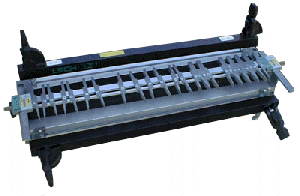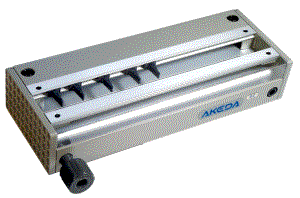|
|
|
Leigh Versus Akeda Dovetail Jig
 |
 |
| The Dovetail King There are numerous dovetail jigs on the market today in a wide array of price ranges and capabilities. One of the most widely known is the Leigh dovetail jig which has been regarded by many as the "king of the hill" among dovetail jigs. Irregardless of whether or not the Leigh actually is the true king, a usurper has recently laid claim to that throne - the Akeda dovetail jig (also known as the Trend DC400 dovetail center). Comparisons Because the Akeda was expressly designed to compete in the Leigh market niche and it is a template based system, there will be numerous similarities between the systems; there are also several important differences. Listed below are the major areas of comparison. |
|
Guiding |
|
| Akeda | Leigh |
| The Akeda uses a guide
bushing that rides against a series of movable plastic fingers. The router rests on the
top of the jig base, not the plastic fingers. Another aspect relating to guiding is support. Because the router is more fully supported by an unchanging plane, control seems to be greater when compared to the Leigh. The more confined nature of the enclosed design also presents a problem, care must be taken in use so as not to rout into unwanted areas. |
The Leigh uses a guide
bushing that rides against a series of metal finger pairs. These fingers also serve to
support the router itself. Because the router base is resting on the template and the template fingers are wide open on one end, one may experience a certain "tippy" feeling on the entry side of the stock. I've never attributed any actual problem to this however. |
Template |
|
| Akeda | Leigh |
| The fingers for the Akeda are separate, loose, and independent for both tails and pins and the TD pins are unique for the different dovetail angles as well. They are snapped into place and mesh into positioning teeth inside the jig base in increments of 1/8" meaning all the stock should be constrained to multiples of 1/8" in width as well. | The fingers used by the
Leigh are held in place by a guide bar and are infinitely adjustable; they are locked into
position by tightening a screw. The same fingers are used for both through and half blind dovetails although the cutter angles are different. This is accomplished by a multi-profile finger design that comes into play depending on which side of the fingers are used. The template assembly indicates which mode (through / half blind) the user is in. |
Layout |
|
| Akeda | Leigh |
| To layout joint positions
one snaps in the individual fingers as desired. Because different fingers are used for
pins and tails the position of each finger must be recorded in order to place the opposing
set correctly. The Akeda claims "variable spacing" but the position of the fingers can be made in only 1/8" increments. The overall width of each pin is not truly variable but it can be moved from one spot then another and re-routed. This is such a cumbersome (prone to error) method that it makes any claim to true variability in width quite suspect. |
To layout joint positions
one moves the finger pairs along the rail in whatever position and finger width desired
then locking them in place using the screw inside each finger. Because the Leigh allows for true infinite positioning and the layout can be changed with such ease I find that it makes for a much quicker and more intuitive process. |
Accuracy |
|
| Akeda | Leigh |
| The fingers on
the Akeda are constrained to 1/8" increments. This ultimately translates the jig into
the "digital domain" insofar as positioning accuracy. There is very little aside from the "adjustment" issues listed below that could throw off the accuracy of the jig. |
Aside from the greater
repeatability for the Akeda, there is in truth very little meaningful difference regarding
accuracy between these jigs. Any misalignment error made when using the jig should be
attributed to "operator error". Aside from the "digital" constraint of the Akeda, neither system has any clear advantage over the other so as to predispose the operator away from making a gross error; ie: nothing is idiot proof nor are either of these jigs "idiot friendly". |
Adjustment |
|
| Akeda | Leigh |
| The Akeda has been
specifically designed to offer no adjustment to the template system itself. However its
claims of "no adjustment required" is fundamentally not true. There are in
fact adjustments required. All the fixed template design does is move the fit equation from the template and into the guide bushing and bit diameter. This ultimately translates into fewer opportunities to correct the fit since it is harder to make corrections changing bit and guide bushings than it is to move a template. The design of the Akeda in particular is closely dependant upon the guide bushing being nearly perfect; Standard guide bushings are NOT purposefully made to the tolerances required. Since the template is fixed, adjustments are made using two additional proprietary router bits (the straight cutters) which are 0.004" under and oversize and / or using two 0.004" under and oversize precision guide bushings. As a result of this design, if the tolerance stackup of the guide diameter, router bit diameter, and spindle runout does not result in the desired fit, the user must start swapping router bits and guide bushings to try and find the right combination to achieve the desired fit. This is more of a hassle than simple reading a scale and moving the template. It should be noted that the over and under size router bits and guide bushings required to obtain adjustability are NOT standard therefore the base jig actually has NO adjustment capability. |
There is a scale at either
end of the Leigh finger assembly that is set according to the diameter of the bit.
This system is geometrically predisposed to offering the user very fine control of the
joint fit. This also allows the user to account for any guide bushing size variances with ease. Using the scale, a user is actually able to compensate for the smallest of fit variations including those related to the compressibility of different species of wood fiber. |
Capability |
|
Akeda |
Leigh |
| The maximum
joint width is 16". This is fine for most boxes the size of drawers but a few inches
shy of being able to handle casework such as blanket chests. This isn't a complete show stopper since pieces can be joined later to form larger boards. It does however present another opportunity for error using a joint that is very intolerant of error. The maximum dovetail depth is 3/4" for through dovetails. |
The maximum
joint width is 24". Not only does this put Leigh into the realm of being able to
handle casework, it covers any reasonable need when setting up to cut asymmetrical layouts
of drawer sized boxes. The maximum dovetail depth is 1 ¼" for through dovetails. |
Dust Collection |
|
| Akeda | Leigh |
| Being an enclosed design means the Akeda will naturally prevent chips from being thrown at the user. The dust collection accessory makes the Akeda much cleaner both in term of chips and ergonomics. I highly recommend the dust collection hood. | The Leigh offers no dust
collection capability of it's own. Leigh does offer a dust collection hood that can be
fitted to the router and this does take care of most of the dust but it makes the router
more cumbersome to handle. The Leigh hood can also be used on other jigs and for edge routing freehand. |
Cost |
|
| Akeda | Leigh |
| The base cost of the Akeda
is about $330. Since there is no adjustment possible with this configuration, the under
and over size router bits ($18 each) should be purchased along with the sliding dovetail
device, this brings the cost to a realistic comparison sum of $366. I would also
recommend the dust collection accessory for an additional $30. A fully loaded dovetail cutting system comparable to the Leigh would run over $500. |
The base cost of the Leigh
is about $360. A fully loaded (dovetail) cost would depend upon which (of the several to
choose from) router bits were desired (I get by with only 5 more); a reasonable estimate
would be about $460. Note that both jigs will also need router guide bushings. In contrast to the Akeda I do not universally recommend the Leigh dust collector although it does work. |
Cutters |
|
| Akeda | Leigh |
| The Akeda requires a special set of dovetail and straight cutters. As of this writing, these cutters are just becoming available through a third party maker (Whiteside). | The Leigh also requires a special set cutters. They are widely available from many manufactures and vendors. Many of the cutters for the Leigh are also available in 8mm shanks which offer an improvement over the ¼" shank sets. |
Documentation |
|
| Akeda | Leigh |
| While adequate, the Akeda manual falls short of the very high standard set by Leigh. It is even a little sparse in some respects. | The documentation for the Leigh is exceptional, I have simply never seen anything better. It clearly describes and illustrates every single step involved in assembly, setting, and using the jig. |
Summary
Advantage Leigh:
If you found this article of interest here are some others that may be useful as well: Review of the Leigh dovetail jig |